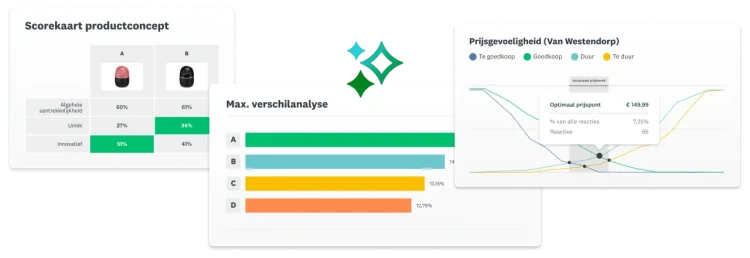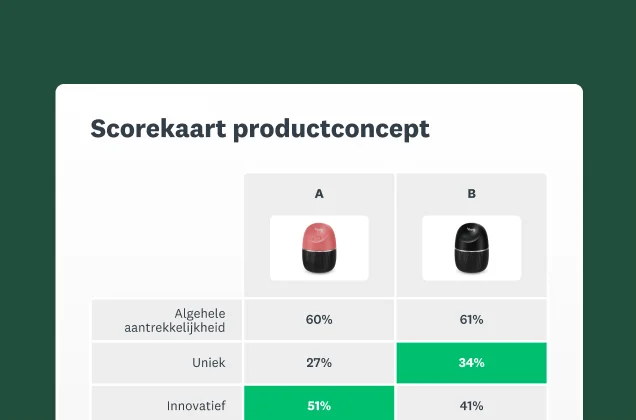
Oplossingen voor marktonderzoek
Door AI aangedreven inzichten verzamelen met onze flexibele oplossingen voor marktonderzoek
Neem betere beslissingen op basis van inzichten in uw markt, branche en klanten. Maak een gratis account en krijg snel feedback.





Met SurveyMonkey is marktonderzoek snel en gemakkelijk
Kies naar wie u uw enquête wilt sturen
Selecteer uw doelgroep om een gedetailleerde offerte te krijgen. We sturen uw enquête naar mensen uit ons wereldwijde panel die aan uw criteria voldoen. Kom in contact met meer dan 335 miljoen mensen in meer dan 130 landen, van consumenten tot professionals.
Laat het zware werk aan AI over
SurveyMonkey maakt gebruik van AI om elke fase van uw onderzoek te ondersteunen, van het maken van de enquête tot het vinden van trends en patronen in uw gegevens.
Snelle inzichten om betere beslissingen te nemen
Met ons intuïtieve platform kunt u gemakkelijk data op schaal verzamelen en analyseren. Onze veeleisende normen voor gegevenskwaliteit zorgen ervoor dat uw resultaten nauwkeurig zijn. En dankzij aangepaste rapporten en exporttools kunt u presentatieklare inzichten snel delen.
Door experts gemaakte oplossingen
Ken uw doelgroep, blijf de markt een stap voor en laat uw merk groeien
Vind nieuwe kansen en blijf concurrerend op een markt die continu verandert
Ontdek wat de voorkeuren, gewoonten en het aankoopgedrag van uw consumenten zijn.
Prijsoptimalisatie (Van Westendorp)
Vind het optimale prijspunt en prijsklasse voor uw product of service.
Neem betere beslissingen over producten en marketing.


Test uw ideeën voordat u investeert en overtuig stakeholders sneller
Test productideeën en vergelijk ze met benchmarks uit de branche.
Test en geef prioriteit aan producten of creatieve ideeën in de beginfase.
Test verschillende namen voor uw merk, product of service.
Ontdek wat het beste logo-ontwerp is voor uw merk of producten.
Verzamel feedback van uw doelgroep over ontwerpen van uw verpakkingen.
Start geslaagde campagnes en ga vol vertrouwen de markt op
Test uw marketing- en advertentiecampagnes voor de lancering van een product.
Ontvang feedback op berichten, slogans, productteksten en meer.
Ontdek wat uw doelgroep van uw video's vindt.


Ontvang binnen een uur inzichten in uw doelmarkt
Profiteer van de betrouwbare inzichten van meer dan 335 miljoen mensen in meer dan 130 landen, met meer dan 200 unieke afstemmingsopties. We schonen uw data automatisch op en verwijderen reacties met een lage kwaliteit, zodat u vol vertrouwen beslissingen in real time kunt nemen die zijn gebaseerd op betrouwbare inzichten.
Meer hulpbronnen om uw onderzoek te verbeteren

Vijf fasen van de levenscyclus van een product
Test uw producten voordat u de markt opgaat met de oplossing om concepten te testen van SurveyMonkey.

Wat gebeurt er nadat u een SurveyMonkey Audience-project start
Ontdek wat u kunt verwachten zodra uw project live is en reacties verzamelt.

Wat is er allemaal nieuw bij SurveyMonkey?
Lees meer over onze nieuwste productupdates en functies. Maak enquêtes en formulieren om snel feedback en krachtige inzichten te krijgen.

We testen de kwaliteit van ons Audience-enquêtepanel
Hoe ons onderzoeksteam ervoor zorgt dat uw enquêtes doordachte, consequente reacties verzamelen.
Blijf de concurrentie een stap voor
Ga vol vertrouwen de markt op met onze door experts gemaakte oplossingen voor marktonderzoek.